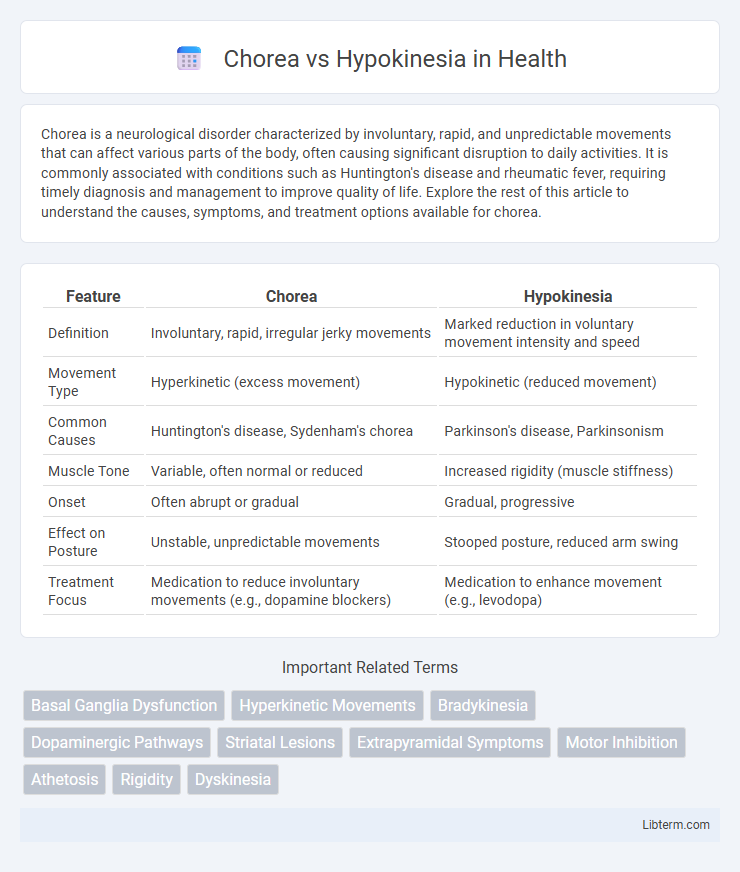Chorea is a neurological disorder characterized by involuntary, rapid, and unpredictable movements that can affect various parts of the body, often causing significant disruption to daily activities. It is commonly associated with conditions such as Huntington's disease and rheumatic fever, requiring timely diagnosis and management to improve quality of life. Explore the rest of this article to understand the causes, symptoms, and treatment options available for chorea.
Table of Comparison
| Feature | Chorea | Hypokinesia |
|---|---|---|
| Definition | Involuntary, rapid, irregular jerky movements | Marked reduction in voluntary movement intensity and speed |
| Movement Type | Hyperkinetic (excess movement) | Hypokinetic (reduced movement) |
| Common Causes | Huntington's disease, Sydenham's chorea | Parkinson's disease, Parkinsonism |
| Muscle Tone | Variable, often normal or reduced | Increased rigidity (muscle stiffness) |
| Onset | Often abrupt or gradual | Gradual, progressive |
| Effect on Posture | Unstable, unpredictable movements | Stooped posture, reduced arm swing |
| Treatment Focus | Medication to reduce involuntary movements (e.g., dopamine blockers) | Medication to enhance movement (e.g., levodopa) |
Introduction to Chorea and Hypokinesia
Chorea is characterized by involuntary, rapid, and irregular movements often seen in conditions like Huntington's disease, reflecting hyperkinetic motor dysfunction. Hypokinesia involves reduced movement amplitude and slowness, commonly associated with Parkinson's disease, indicating a deficit in motor initiation and execution. Understanding these opposing movement disorders aids in diagnosing and managing basal ganglia-related pathologies.
Defining Chorea: Characteristics and Symptoms
Chorea is characterized by involuntary, rapid, irregular, and jerky movements predominantly affecting the face, hands, and feet, often appearing dance-like and unpredictable. These hyperkinetic movements result from dysfunction in the basal ganglia, disrupting the balance between excitatory and inhibitory motor pathways. Symptoms include sudden, uncontrolled muscle contractions, impaired voluntary movement, and difficulty maintaining posture, contrasting with the slowed, reduced motion seen in hypokinesia.
Understanding Hypokinesia: Core Features
Hypokinesia, a hallmark of Parkinson's disease, is characterized by reduced movement amplitude and slowness of voluntary actions, reflecting basal ganglia dysfunction. Unlike chorea, which involves involuntary, rapid, and irregular jerky movements, hypokinesia presents as diminished motor activity, rigidity, and bradykinesia. Key features include masked facial expressions, decreased arm swing during walking, and difficulty initiating movements, highlighting impaired motor control and coordination.
Causes of Chorea: Major Disorders and Triggers
Chorea is primarily caused by neurological disorders such as Huntington's disease, rheumatic fever (Sydenham's chorea), and autoimmune conditions like systemic lupus erythematosus. Infections, metabolic imbalances, and certain medications can also trigger chorea symptoms. Unlike hypokinesia, which is often linked to Parkinson's disease and dopaminergic neuron loss, chorea involves excessive, involuntary movements due to basal ganglia dysfunction.
Etiologies of Hypokinesia: Underlying Conditions
Hypokinesia primarily results from neurodegenerative disorders such as Parkinson's disease, where dopamine-producing neurons in the substantia nigra degenerate, leading to reduced motor activity. Other etiologies include atypical parkinsonian syndromes like multiple system atrophy and progressive supranuclear palsy, which affect various brain regions involved in movement control. Secondary causes encompass drug-induced parkinsonism and vascular parkinsonism, both contributing to diminished voluntary movement through different pathological mechanisms.
Pathophysiological Differences Between Chorea and Hypokinesia
Chorea involves hyperkinetic movement disorders characterized by rapid, involuntary, and irregular muscle contractions due to dysfunction in the indirect pathway of the basal ganglia, leading to decreased inhibitory output to the thalamus. Hypokinesia manifests as reduced movement amplitude and speed, typically associated with Parkinson's disease, resulting from dopaminergic neuron loss in the substantia nigra pars compacta and subsequent impaired facilitation of the direct basal ganglia pathway. These distinct pathophysiological mechanisms result in excessive movement in chorea versus diminished motor activity in hypokinesia.
Diagnostic Methods for Chorea and Hypokinesia
Diagnostic methods for chorea primarily include clinical neurological examination, genetic testing for Huntington's disease, and brain imaging such as MRI to identify basal ganglia abnormalities. Hypokinesia diagnosis often involves assessments like the Unified Parkinson's Disease Rating Scale (UPDRS), dopamine transporter (DAT) imaging using SPECT, and response evaluation to dopaminergic medications. Both conditions necessitate thorough history taking and differential diagnosis to distinguish from other movement disorders such as dystonia or tremor.
Clinical Presentation: Key Differences in Movement Patterns
Chorea is characterized by rapid, involuntary, irregular, and jerky movements that flow unpredictably from one body part to another, often seen in conditions like Huntington's disease. Hypokinesia presents with a marked reduction in the amplitude and speed of voluntary movements, manifested as bradykinesia and rigidity, most commonly observed in Parkinson's disease. These contrasting movement patterns--excessive, unpredictable motions in chorea versus diminished, slow movements in hypokinesia--are critical for differential diagnosis in movement disorders.
Treatment Approaches for Chorea vs Hypokinesia
Treatment approaches for chorea typically involve dopamine-depleting agents such as tetrabenazine or antipsychotics like haloperidol to reduce involuntary movements, while hypokinesia is primarily managed with dopaminergic therapies like levodopa or dopamine agonists to enhance motor function. In chorea, symptom control aims to suppress hyperkinetic activity, whereas hypokinesia treatment focuses on improving bradykinesia and rigidity associated with conditions like Parkinson's disease. Deep brain stimulation and physical therapy serve as adjunct treatments for both movement disorders, tailored to individual patient needs.
Prognosis and Quality of Life Considerations
Chorea, characterized by involuntary, rapid, and unpredictable movements, often presents a challenging prognosis due to its association with progressive neurological conditions like Huntington's disease, leading to substantial functional decline and impaired quality of life. Hypokinesia, commonly observed in Parkinson's disease, manifests as reduced movement amplitude and slowness, frequently resulting in mobility limitations, increased fall risk, and decreased independence. Management strategies targeting symptom control and rehabilitation can partially improve prognosis and quality of life, but both conditions typically necessitate long-term multidisciplinary care to address evolving motor and non-motor impairments.
Chorea Infographic

 libterm.com
libterm.com